2-2-1 Vance Walberg
 | 1 Vance Walberg Find a way to win when you don't shoot well, get to the foul line, and create more turnovers. The 2-2-1 principles can be applied to any defence. When the ball is on an outside quarter of the court, all defenders are on that half of the court; when the ball is on an inside quarter, all defenders are in the two inside quarters. Don't hug your man, play on the high side (up the line). Defensive keys are great ball pressure, get to your quarters, and the defence begins on an attack dribble. Make them dribble, it's a lot more tiring to dribble up against pressure, the wear-down factor is very important. He loves active hands, looks for tips. There are five defensive spots or positions, controller X1, gapper X2, taker X3, reader X4, and teaser X5. The controller is a tough SOB, not the best offensive player, he will get in foul trouble more than anyone else. He controls the whole defence with his pressure, does not allow a straight-line pass. The taker is on the same side, takes away a pass up the ballside sideline, can be a little slow as long as he is smart. The gapper is one pass away on the same horizontal as the controller, he is a better offensive player than the taker, will have chances to score on steals. The reader is like a free safety, aggressive, looking for steals. The teaser always has long and opposite (never square to the ball), most of the time he is the big guy. See Walberg Press 101 (YouTube). |
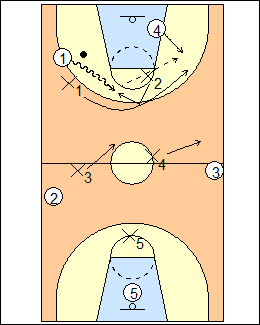 | 2 Ball pressure is key, don't let the ballhandler see the floor, make him put it on the floor (an attack dribble, not a standing or sucker dribble), and turn him in the frontcourt. They don't care which way you force, the gapper always turns into a trapper, he runs to trap if 1 drives up the sideline or the middle (shown). X2 can't get gapped, i.e., let 1 split him and X1. If 1 passes in the air off the dribble to 4, X1 runs and jumps (switches to 4, shown); if 1 stops, trap him. On the pass to 4, the on-ball defender is controller, the reader becomes taker, and the taker becomes reader, with all the same rules. See Defences - Scramble fullcourt (slow trap), Morgan Wootten fullcourt (funnel trap). |
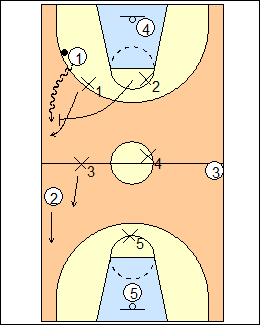 | 3 Here X2 runs to trap when 1 drives up the sideline, X1 has to turn 1 and X2 traps from the side. In a trap, don't foul, and don't get split. See Defence - 2-2-1 John Kimble ("in" stunt). |
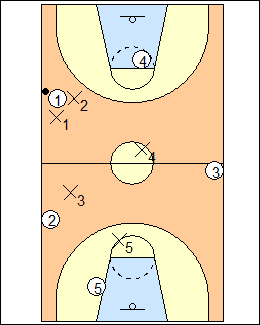 | 4 X3 takes away a pass up the sideline. X4 looks to pick off a reversal pass if the trailer leaks up the middle, but can't get to it if 4 stays way back. Good players move on the pass, great players move on the pivot and sprint on the pass. Never have three on the ball, or three behind ball level. |
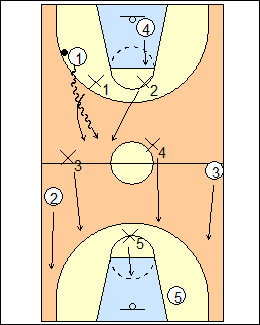 | 5 On a bad beat, get to ball level and to your quarters. When 1 blows by, X1 sprints and tries to get a punch-out (back tip) from behind, X2 sprints back trying to squeeze 1. The taker, reader and teaser fall back and form an umbrella, the taker and reader can stay high (not all the way back to the key) so long as X5 is protecting the basket. If you run the defence right, you will get more steals from behind than from traps. |
 | 6 Vertical trap on any pass ahead and catch in the "cushion zone" between the backcourt and frontcourt hash marks. X4 plays cat and mouse on the ball, keeping a cushion (if he gets beat, there will be three defenders behind the ball) and waiting for the vertical trap. X1 and X2 sprint back (they're behind the ball), X2 sprints to trap (he's in the same lane as the ball), X1 sprints to ball level and to his quarter, is in see-it-and-fix-it mode, if he sees a good trap coming, cover a pass out instead of running all the way back. X3 and X5 fall back to form an umbrella. See Defence - 2-2-1 UConn (pass ahead, and a long pass). |
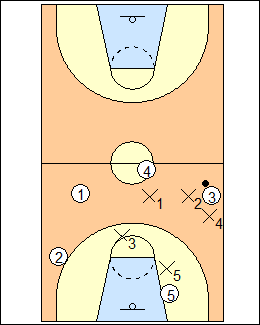 | 7 When you have two defenders on the ball, there's always going to be one guy (furthest away) guarding two, here it's X3. |
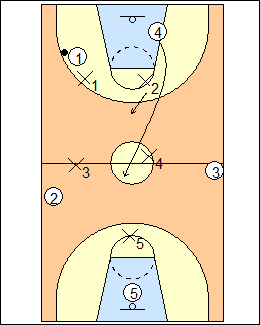 | 8 Phasing - if the gapper's man cuts through and leaves the gapper zone, let him go, optionally the reader can tell the gapper to go trap. |
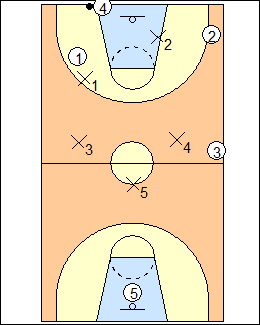 | 9 Inbounds pass 4 has the ball out of bounds, X1 is strong, X2 is weak, and will reverse roles if 4 runs the baseline. The taker, reader and teaser read the inbounder's eyes, X5 tries to tease the inbounder into making a fullcourt pass. It's full denial if the offence uses a one-guard front (1-up), against two guards (2-up, shown), X1 forces 1 towards the corner, X2 denies on the weakside, in his quarter. If 3 flashes middle, reader X4 comes with him. |
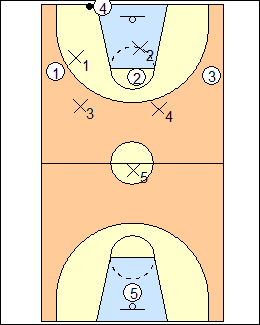 | 10 Against 3-up, you don't want them getting the ball in the middle or on the run, give them the furthest pass, here to 3 (then X2 would come over). |
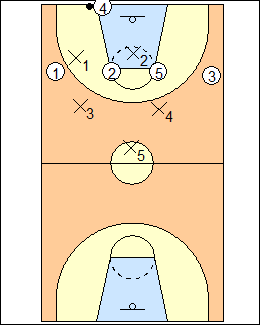 | 11 Against 4-up, X2 plays two attackers. |
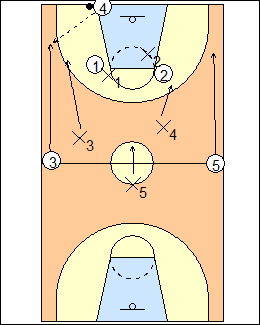 | 12 If they use two guards and flash two players from halfcourt, the taker and reader come with them. |
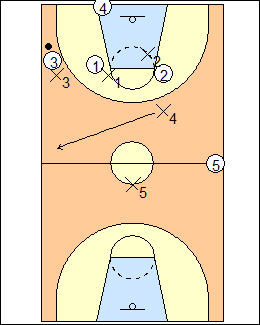 | 13 |
This page was made with Basketball playbook from Jes-Soft
